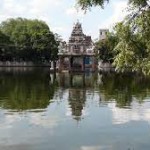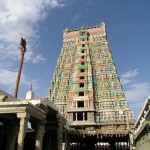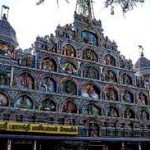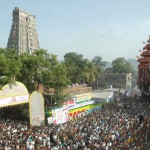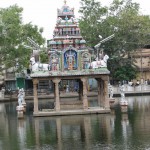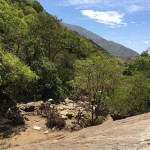| Virudhunagar Districts |
| About: |
| Virudhunagar district are some of the most revered ones in the south Indian state of Tamil Nadu. Virudhunagar District is surrounded by Madurai District in the north, Sivagangai District in the northeast, Ramanathapuram District in the east and Tirunelveli and Tuticorin districts in the south. Other than being a sacred destination, this district is also a major exported of granites, different grades of limestone and minerals such as clay and gypsum are found. The chief crops are cotton, pulses, oilseeds and millets. Other than the temples of Virudhunagar district, Kamarajar`s House, Pilavakkal Dam near Watrap, Ayyanar falls and Sastha Koil near Thevathanam, Andal Koil at Srivilliputhur, Boominatharkoil and birthplace of Ramana Maharishi at Thiruchuli, Rajapalayam are the major tourist attractions.Virudhunagar District is landlocked on all sides with no direct access to the sea. It is bound on the north by Madurai, on the north-east by Sivaganga, on the east by Ramanathapuram and on the south by Tirunelveli and Tuticorin districts.The District consists of red loam, red clay loam, red sand, black clay and black loam in large areas with extents of black and sand cotton soil found in Sattur and Aruppukottai taluks. Limestone of different grades and common use minerals like sand, clay and gypsum are the minerals of economic value found. Granite of export value occurs in small pockets in the southern regions of the District. Physiographically it consists of two distinct regions. The eastern slopes of the Western Ghats in Srivilliputtur and Rajapalayam taluks and the black soil plains of Sivakasi, Virudhunagar, Sattur, Aruppukkottai, Tiruchili and Kariapatti. The average height of the hills of the eastern slopes of the Western Ghats is 1500m, though a few peaks rise to 1700m. The highest peaks are Peyimalai Mottai and Kottamalai. The foothills have rich loamy soil with good vegetation cover. The plains with black cotton soil (locally known as karisal) have underlying cal carious formations. |
| Virudhunagar does not have any perennial rivers. The Vaippar, Arjuna nadi, and Gundar constitute the river network of the District. Numerous streams and rivulets, activated by the monsoon, feed these rivers. The Mandiri odai and Girudhamal nadi flow into the Gundar, which irrigates the northeastern region of the District. The Sengundrapuram odai, Kausika manadi, Uppodai and Mannarkottaiyar are feeder streams of the Arjuna nadi, which flows through the central portion of the District. The Kayalkudiyar and Nichepa nadi join the Vaippar, which runs through the southern part of the District. The Arjuna and the Vaippar meet at Irukkangudi. |
| Location info: |
| Virudhunagar District,Tamil Nadu,India |
| Climate/Weather of Virudhunagar Districts: |
| The climate of the region is semi-arid tropical monsoon type. It has a high mean temperature and a low degree of humidity. The temperatures range from 20° C to 37° C. April, May and June are the hottest months of the year. Virudhunagar receives scanty rainfall with an annual average of 812 mm. The South West monsoon which sets in June and lasts till August brings scanty rain. The bulk of the rainfall is received during the North East monsoon in the months of October, November and December. |
| History of Virudhunagar Districts: |
| From the 19th century AD, District Collectors and Judges appointed by the British controlled the area. In 1910, the District of Ramanathapuram was created for reasons of administrative convenience, by carving-out territories from Madurai and Tirunelveli Districts. In 1948, after India attained independence, the zamins were abolished.In 1985, the Ramanathapuram District was trifurcated to create the districts of Ramanathapuram, Pasumpon Muthuramalinga Thevar Tirumagan(later renamed Sivaganga) and Kamarajar District (later renamed Virudhunagar District).The District headquarters is Virudhunagar town. It covers an area of 4232 sq. km. and is divided into 8 taluks, namely Aruppukkottai, Kariapatti, Rajapalayam, Sattur, Sivakasi, Srivilliputur, Tiruchuli and Virudhunagar. |
| Educational Institutions of Virudhunagar Districts: |
| Arts & Science:Sri Kaliswari College, Sivakasi V.P.M.M. Arts and Science College for Women, Srivilliputtur Taluk Rajapalayam Raju’s College, Rajapalayam S.B.K. College, Aruppukootai Sri S. Ramasamy Naidu Memorial College, Sattur V.H.N.S.N. College, Virudhunagar V.V.V. College for Women, Virudhunagar A.K.C. College of Arts and Science, Virudhunagar A.K.D. Dharmaraja’s Women’s College, Virudhunagar A.N.J.A. College (Autonomous), Sivakasi Devanga Arts College, Aruppukottai The Standard Fireworks Rajarathinam College for Women (Autonomous), Sivakasi Hotel Management:Sri Kaliswari College, Sivakasi Sri S. Ramasamy Naidu Memorial College, Sattur National Academy of Hotel Management and Catering Technology, VirudhunagarEngineering:MEPCO Schlenk Engineering College, Sivakasi V.P.M.M. Engineering College for Women, Srivilliputtur Taluk Kalasalingam Institute of Technology, Srivilliputhur Kalasalingam University (Arulmigu Kalasalingam College of Engineering), Virudhunagar Kamaraj College of Engineering and Technology, Virudhunagar P.S.R. Engineering College, Sivakasi P.S.R. Rengasamy College of Engineering for Women, Sivakasi Sree Sowdambika College of Engineering, Aruppukottai Taluk Sri Vidya College of Engineering and Technology, VirudhunagarNursing:Suran College of Nursing, Srivilliputtur TalukManagement:MEPCO Schlenk Engineering College, Virudhunagar Ayya Nadar Janaki Ammal College (Autonomous), Sivakasi Kalasalingam University (Arulmigu Kalasalingam College of Engineering), Srivilliputtur (Via) P.S.R. Engineering College, Sivakasi Sri S. Ramasamy Naidu Memorial College, Sattur The Standard Fire Works Rajaratnam College for Women (Autonomous), Sivakasi V.V. Vanniaperumal College for Women, Virudhunagar Virudhunagar Hindu Nadar’s Senthilkumara Nadar College, Virudhunagar |
| Langauge |
| The city has a multi-cultural society with a sizeable presence of Tamil, English, Marathi, Telugu, Hindi, and Malayalam-speaking population. The city projects a calm outlook and is considered to be friendly toward tourists. |
| Culture: |
| People, Culture & Festivals of Tamil Nadu reflects the pulsating tradition of the place that is enriched with the diverse socio-cultural customs and conventions. Tourists visiting this enticing place not only enjoy the natural splendors but also experience the warmth and unity of the inhabitants of the region. |
| How to reach? |
| Nearest Railway Station:Both Broad Gauge and Metre Gauge sections of the Southern Railway serve Virudhunagar. The newly laid Broad Gauge line links Tuticorin with Chennai. |
| Nearest Airport:Trichy, Viralimalai, Thuvarankuruchi, Madurai, Aruppukkottai, Tuticorin–32.6 km. |
| Road Transport:Three National Highways pass through the district. The road transportation is convenient and comfortable. You can reach by bus or by car. |
| Tourist Attraction of Virudhunagar Districts: |
| Kalainathaswamy Temple : Kalainathaswamy Temple is one of the major temples of Virudhunagar district, located at Pallimadam and Vira Pandya had built this somber shrine (Pallipadai) at Pallimadam for his brother Sundara Pandya, a famous Pandya ruler. Earlier known as Pallippadai Sundara Pandya Isvaramudayar Kovil, this shrine is now called Kalainathaswamy Kovil. It is a unique funereal temple of its kind during the era of Pandya Nadu. Srivilliputtur temple, located in Srivilliputtur town in Tamil Nadu is believed to be the birthplace of Andal, the wife of Lord Vishnu. Andal, also the author of Tiruppaavai, is known to celebrate the collection of 30 poems. This temple is one among the holiest of the 108 Divya Desam temples of Virudhunagar district dedicated to Lord Vishnu.The temples of Virudhunagar district are all situated in higher elevation, similarly the temple tower of Kalainathaswamy Temple one among the tallest towers in TamilNadu, is twelve-storeyed and rises to a height of 192 ft. Features delicate carvings. In the north eastern segment of the temple complex is the Vatapatrasayee temple, this temple boasts shrines dedicated to each of the ten incarnations of Lord Vishnu.Tirumeninathar Temple: Tirumeninathar Temple, one of the best-known temples of Virudhunagar district is located at Tiruchuzhiyal and spans an area of about 45000 square feet. The temple deity is Tirumeninathar. The Sthala teertham is Pralaya teertham. Saint Sundarar is said to have composed pathigams in praise of the lord. Main festivals celebrated here are the grand Brahmotsavam in Panguni (mid March – mid April), Palani Andavar festival in Thai (mid January – mid February), and the Amman Tapas festival in the month of Aadi (mid July – mid August). The temples of Virudhunagar district are visited by thousands of pilgrims every year.Bhuminathaswamy temple: Tiruchuli is located on the southern bank of the Gundar. The Bhuminathaswamy temple at Tiruchuli is counted among the 14 famous Shaiva centres in Pandya nadu. Its located 40 Kms. East from Virhdunagar, 45 Kms South from Madurai. Name of God is Bhuminathar, Godess is Thunaimalai Amman. Its deity has been venerated in the hymns sung by Shaivite Nayanar Sundaramoorthy and Sekkilar. The temple has undergone extensive renovations and the present complex accommodates a number of shrines built over time within the high boundary walls constructed during the reign of Muthuramalinga Setupati.Swami Vivekananda was stayed three days in this temple due to the flood of Gundar river in his yatras.Pallimadam: Pallimadam is situated on the outskirts of Tiruchuli on the eastern bank of the river Gundar. Sundara Pandya, a 10th century AD Pandya ruler, famous for his erudition, died while visiting Pallimadam. He was buried there and his younger brother Vira Pandya (AD 946-966) erected a sepulchral shrine (pallipadai) over his grave. The temple was known as Pallippadai Sundara Pandya Isvaramudayar koil. It is now called Kalainathaswamy koil. The name Pallippadai has over the years been corrupted to Pallimadam. This sepulchral temple is the only one of its kind in Pandya nadu.Ramana Maharishi Ashram: Sri Ramana Maharishi was born in 30.12.1879 at Thiruchuli. His mother is Thirumathi. Azhagammal, father is Thiru. Sundaram Iyer. He was lived in the house of ‘Sundara Mandhiram”.Arul Migu Thirumeni Nadha Swamy temple is situated on the State Highways of Srivilliputur to Parthipanur. this temple is ten of the Pandiya’s Thalam out of fourteen in Tamil Nadu. This temple has 9 kinds of Theerthas and 8 kinds of lingas.Bhagwan Sri Ramana Maharishi was born at Tiruchuli. An ashram was established in 1988 on the banks of the river Gundar to propagate his teachings.Aruppukkottai town: Aruppukkottai is a renowned weaving centre. Both handloom and powerloom weaving are undertaken. In the handloom sector both silk and cotton sarees are woven. The powerloom units weave towels, sarees, lungis, bedsheets and bedcovers. Units for spinning yarn as well as units for dyeing yarn have been established here.Kullursandai reservoir: The Kullursandai reservoir on the Kowsiga mahanadi, a tributary of the Arjuna nadi. Is being developed into a picnic spot. Boasting facilities are offered at the reservoir which also attracts numerous water birds in the months of August to February.Guhanparai: Guhanparai is located on the road to Kalugumalai from Vembakkottai. A small hillock to the west of the village is called Guhanparai and the village takes on the same nomenclature. There is a small natural cavern at the foot of the hillock, which is believed to have been used as a shelter by Jain monks. A 10th century AD Vatteluttu inscription on a rock of the hillock states that a monastery Munnurruvarperumpalli was established in the name of Munnurruvar kovilpillaigal (servants of the palace).Irukkangudi: Irukkangudi is located to the east of Sattur, at the confluence of the Arjuna nadi and the Vaippar. The Mariamman koil, located close to the confluence, is a popular spot for devotees. The Panguni Uttiram is an important festival celebrated in the month of Panguni for 21 daysMariamman Koil: The Mariamman temple in the town was constructed in 1923. The Panguni Uttiram, celebrated in the month of Panguni for 21 days at this temple, is the main festival of the town and its surroundings.Kamaraj’s House: The house where the great leader Kamaraj was born has been converted into a memorial. The rooms are adorned with photographs of the leader at every stage of his life. A few of his clothes, his watch as well as articles used by him are displayed.Sivakasi town: Sivakasi is famous for its match and fireworks units as well as for printing. Some of the most advanced printing units in the country are located here offering state of the art, world class facilities. 70% of the total production of matches and fire works in India are manufactured mainly in the towns of Sivakasi and Sattur.Tiruthangal: Tiruthangal is located on the road from Virudhunagar to Sivakasi. The area around the town has been under almost continuous occupation since 4000 BC. Three Sangam age poets – Mudakkorranar, Porkollan Vennahanar and Athireyan Sengannanar were said to have lived at Tiruthangal. The ancient name of the town was Thangal. The town is mentioned in the SilappadikaramOn top of a low hillock in the town there is a structural temple Ninranarayanaperumal koil originally constructed during the Early Pandya period. The temple is considered one of the 108 sacred sites of the Vaishnava faith. Bhuthathalvar and Tirumangaialvar have sung hymns in praise of the temple. A bronze image of Tirumangaialvar was installed in the temple in the 10th century AD. The Ninranarayanaperumal koil was renovated in the 13th century AD and completely rebuilt in the Nayak period.Vembakottai: The Vembakottai Reservoir System receives water from 7 distributaries of the Vaippar. These streams originate in the eastern slopes of the Western ghats. The reservoir is a scenic spot ideal for picnics. It is being developed into a tourist spot with landscaped gardens and boating facilities.Andal , Vadabadrasayi koil: Godha, or Naachiyaar or Andal was born in Srivilliputur – Thiruvilliputur – a beautiful village slowly turning into a town. Srivilliputur is on the Virudhunagar – Thenkasi train route, about 65 km. south of Madurai, very well-connected by road with Madurai, Tenkasi, Tirunelveil, Sivakasi and Sattur.The Lord of Srivilliputtur is known as Vatapatrasayi or Rangamannar. The banyan tree leaf – which is known as Vatapatram, on which the Lord rests in the form of a baby during deluge.Srivilliputur is one of the 108 sacred Vaishnavite kshetras. The town is famous for the Vadapadrasayi temple, Which houses the Andal temple. The Nayak Kings constructed the Vatapatrasayi temple. But its story goes a long way back to Pandiya times, when moved by her devotion, Lord Krishna married the poetess-devotee Andal.. The Vadapadrasayi temple consists of three major portions. The northern portion hasthe Pallikonda Perumal shrine (Vishnu in reclining posture). The Andal shrine occupies the southern portion.Shenbagathope Grizelled Squirrel Sanctuary: The forests are found on the eastern slopes of the Western Ghats. Only 6.3% of the total geographical area is under forests. Many rare and endemic varieties of flora and fauna are found along the mountain slopes. A wildlife sanctuary, spread over 480 sq. kms. was established in 1989 at Shenbagathopu in Srivilliputtur taluk.. This sanctuary is contiguous with the Periyar tiger reserve on the south-western side and the Megamalai reserve forest on the north-western side. The altitude varies from 100m to 2010 m above sea level. The sanctuary is home to the endangered, arboreal grizzled giant squirrel Ratufa macrora. This greyish brown squirrel weighs 1 to 1.8 kg. and is the size of a small cat. It measures about 73.5 cms. from nose to tail with the tail being 36 – 40 cm. long. They construct drays at forked branches where the crowns of neighbouring trees meet. This enables the squirrel to move away from the site by jumping from tree to tree when threatened. The home range of an individual is between 0.197 hectarePilavakkal Dam: The Pilavakkal dam on the river has two sections- the Periyar dam and the Kovilar dam. The areas surrounding the dam sites have been landscaped into beautiful gardens. Facilities like boating are offered to tourists. This is an ideal picnic spot.Ayyanar falls: Ayyanar falls is located on the eastern slopes of the western ghats. The falls located in the midst of scenic green vegetation is a popular location for picnics. The best season to visit the falls is from September to January. |
| Hotels/Lodge/Accommodation in Virudhunagar Districts: |
| Arockiaraj Hotel a/c:43, Madurai Road,Virudunagar, Tamil Nadu,India,Ph:04562 420044Hotel Carnation:Thoappu Street, Virudhunagar,Tamil NaduHotel Vijay:122, Tirupparankunram Rd, Vasantha Nagar, Madurai, Madurai, Tamil Nadu,Ph:045 22336321Royal Court:Madurai, Madurai, Tamil Nadu,Ph:045 2435 6666 |
| Links: |
| http://www.virudhunagar.tn.nic.in/http://tamilnaduonline.in/Profile/Culture/ |
